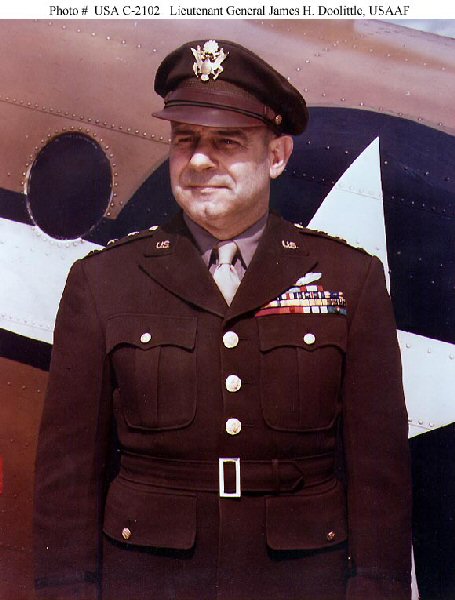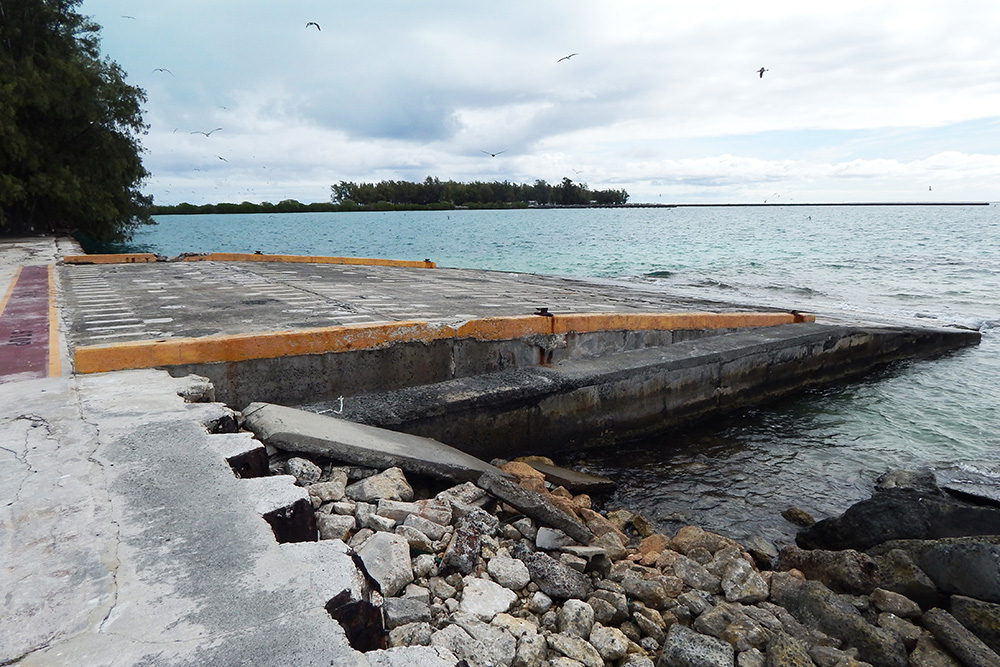Doolittle, James Harold "Jimmy"
- Date of birth:
- December 14th, 1896 (Alameda/California, United States)
- Date of death:
- September 27th, 1993 (Pebble Beach/California, United States)
- Buried on:
- Arlington National Cemetery
- Service number:
- 0-271855
- Nationality:
- American
Biography
Do you have more information about this person? Inform us!
- Rank:
- 1st Lieutenant
- Unit:
- x, U.S. Army Air Service
- Awarded on:
- 1929
"For extraordinary achievement while participating in an aerial flight. On 4–5 September 1922, Lieutenant Doolittle accomplished a one-stop flight from Pablo Beach, Florida, to San Diego, California, in 22 hours and 30 minutes elapsed time, an extraordinary achievement with the equipment available at that time. By his skill, endurance, and resourcefulness he demonstrated the possibility of moving Air Corps units to any portion of the United States in less than 24 hours, thus reflecting great credit on himself and to the Army of the United States."
War Department, General Orders No. 16
- Rank:
- 1st Lieutenant
- Unit:
- x, U.S. Army Air Service
- Awarded on:
- 1929
"For extraordinary achievement while participating in an aerial flight. During March 1924, at McCook Field, Dayton, Ohio, Lieutenant Doolittle, piloting a Fokker PW-7 pursuit airplane, performed a series of acceleration tests requiring skill, initiative, endurance, and courage of the highest type. In these tests a recording accelerometer was mounted in the airplane and the accelerations taken for the following maneuvers. Loops at various air speeds; single and multiple barrel rolls; power spirals; tail spins; power on and power off; half loop, half roll, and Immelmann turn; inverted flight; pulling out of dive at various air speeds; flying the airplane on a level course with considerable angle of bank; and flying in bumpy air. In these tests the airplane was put through the most extreme maneuvers possible in order that the flight loads imposed upon the wings of the airplane under extreme conditions of air combat might be ascertained. These tests were put through with that fine combination of fearlessness and skill which constitutes the essence of distinguished flying. Through them scientific data of great and permanent importance to the Air Corps were obtained."
Second DFC awarded in the form of a bronze oak leaf cluster to be worn on the ribbon of the first DFC. War Department, General Orders No. 16
- Period:
- Second World War (1939-1945)
- Rank:
- Colonel
- Unit:
- 1st Special Aviation Project (Doolittle Raider Force), U.S. Army Air Forces
"For extraordinary achievement as Pilot of a B-25 Bomber and Commanding Officer of the 1st Special Aviation Project (Doolittle Raider Force), while participating in a highly destructive raid on the Japanese mainland on 18 April 1942. Colonel Doolittle with 79 other officers and enlisted men volunteered for this mission knowing full well that the chances of survival were extremely remote, and executed his part in it with great skill and daring. This achievement reflects high credit on himself and the military service."
Third DFC awarded in the form of a second bronze oak leaf cluster to be worn on the ribbon of the first DFC. War Department, General Orders No. 16
- Period:
- Second World War (1939-1945)
- Rank:
- Brigadier General
- Unit:
- 1st Special Aviation Project (Doolittle Raider Force), U.S. Army Air Forces
- Awarded on:
- June 9th, 1942
Citation:
"For conspicuous leadership above the call of duty, involving personal valor and intrepidity at an extreme hazard to life. With the apparent certainty of being forced to land in enemy territory or to perish at sea, Gen. Doolittle personally led a squadron of Army bombers, manned by volunteer crews, in a highly destructive raid on the Japanese mainland."
General Orders No. 29, dated June 9th, 1942.
"For conspicuous leadership above the call of duty, involving personal valor and intrepidity at an extreme hazard to life. With the apparent certainty of being forced to land in enemy territory or to perish at sea, Gen. Doolittle personally led a squadron of Army bombers, manned by volunteer crews, in a highly destructive raid on the Japanese mainland."
General Orders No. 29, dated June 9th, 1942.
- Period:
- Second World War (1939-1945)
- Rank:
- Major General
- Unit:
- Northwest African Strategic Air Force (NASAF), Northwest African Air Forces (NAAF), Mediterranean Air Command (MAC), Allied Forces
- Awarded on:
- 1943
- Awarded for:
- Operation Torch
Citation:
"For exceptionally meritorious and distinguished services to the Government of the United States, in a duty of great responsibility as Commander of the Northwest African Strategic Air Force since its organization. Under his guidance and direction, this Force has developed a high degree of efficiency and accuracy and brought about, in great measure, a critical reduction in the supplies and reinforcements needed by the enemy. General Doolittle's energy, good judgment, exceptional qualities of leadership and wholehearted cooperation were primary factors in the ultimate success of air operations during the Tunisian Campaign."
War Department, General Orders No. 49
"For exceptionally meritorious and distinguished services to the Government of the United States, in a duty of great responsibility as Commander of the Northwest African Strategic Air Force since its organization. Under his guidance and direction, this Force has developed a high degree of efficiency and accuracy and brought about, in great measure, a critical reduction in the supplies and reinforcements needed by the enemy. General Doolittle's energy, good judgment, exceptional qualities of leadership and wholehearted cooperation were primary factors in the ultimate success of air operations during the Tunisian Campaign."
War Department, General Orders No. 49
- Period:
- Second World War (1939-1945)
- Rank:
- Major General
- Unit:
- Northwest African Strategic Air Force (NASAF), Northwest African Air Forces (NAAF), Mediterranean Air Command (MAC), Allied Forces
- Awarded on:
- 1943
Citation:
"For gallantry in action. Since 19 February 1943, when he took command of the Allied Strategic Air Force (Northwest Africa), General Doolittle, by his untiring energy, initiative and personal example has inspired the units under him to renewed successful efforts against the enemy. On 5 April 1943, the strategic air force was responsible for the destruction of forty eight enemy planes in the air and approximately 100 on the ground. This extraordinary achievement under the leadership of General Doolittle reflects great credit to himself and the armed forces of the United States."
Headquarters, Northwest African Strategic Air Force, General Orders No. 37
"For gallantry in action. Since 19 February 1943, when he took command of the Allied Strategic Air Force (Northwest Africa), General Doolittle, by his untiring energy, initiative and personal example has inspired the units under him to renewed successful efforts against the enemy. On 5 April 1943, the strategic air force was responsible for the destruction of forty eight enemy planes in the air and approximately 100 on the ground. This extraordinary achievement under the leadership of General Doolittle reflects great credit to himself and the armed forces of the United States."
Headquarters, Northwest African Strategic Air Force, General Orders No. 37
- Period:
- Second World War (1939-1945)
- Rank:
- Lieutenant General
- Unit:
- HQ, Eighth Air Force, U.S. Army Air Forces
- Awarded on:
- 1944
War Department, General Orders No. 89 (Bronze Oak Leaf Cluster)
- Period:
- Second World War (1939-1945)
- Period:
- Second World War (1939-1945)
Second AM awarded in the form of a bronze oak leaf cluster to be worn on the ribbon of the first AM.
Third AM awarded in the form of a second bronze oak leaf cluster to be worn on the ribbon of the first AM.
Fourth AM awarded in the form of a third bronze oak leaf cluster to be worn on the ribbon of the first AM.
- Period:
- First World War (1914-1918)
- Period:
- Second World War (1939-1945)
- Period:
- Second World War (1939-1945)
- Period:
- Second World War (1939-1945)
- Period:
- Second World War (1939-1945)
- Period:
- Second World War (1939-1945)
- Period:
- Second World War (1939-1945)
- Period:
- Second World War (1939-1945)
- Period:
- First World War (1914-1918)
Sources
- Photo 1: Army Signal Corps Collection in the U.S. National Archives
- Photo: Photograph from the Army Signal Corps Collection in the U.S. National Archives
- - JORDAN, K. N., SR., Yesterday's Heroes, Schiffer Publishing Ltd., Atglen, United States, 1996.
- Valor Awards
























